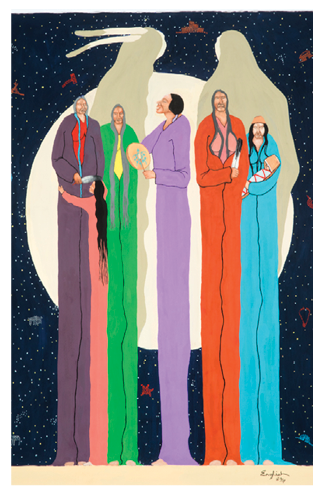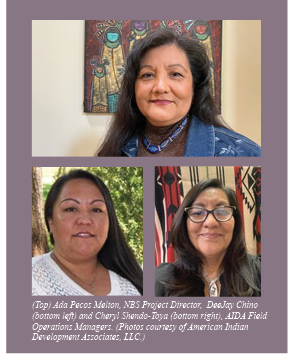The National Baseline Study


There have been decades of grassroots political and social action by American Indian (AI) and Alaska Native (AN) women to address violence in their tribal communities. Their concerns prompted tribal leaders and the U.S. Congress to act at a national level to address these matters. The Violence Against Women and Department of Justice Reauthorization Act of 2005 (VAWA 2005) directly resulted from these efforts.1
The grassroots attention on violence highlighted the limited prevalence estimates available about the violence experienced by AI and AN women,2 especially those living in tribal communities. While several studies have examined these issues, there has never been a national study conducted in tribal communities across the U.S. that collects reliable data and analysis that tribal communities and researchers believe reflect the problem’s true scope.
The National Baseline Study (NBS) is one of many studies resulting from directives outlined in the reauthorization of VAWA 2005. The law authorizes the National Institute of Justice (NIJ), in consultation with the Office on Violence Against Women, to conduct analyses on violence against AI and AN women.3 The NBS is NIJ’s capstone study on violence against Indigenous women. The overarching goal is to understand AI and AN women’s experiences and opinions about health and safety issues in their communities, and their access to community support and services in tribal communities.4
The NBS uses culturally responsive and scientifically rigorous methods to learn the degree and the proportion of AI and AN women affected by crime, violence, and health and safety issues. It is the first nationally representative study of AI and AN women living in tribal communities. The NBS will inform public policies and prevention strategies to decrease the incidence of AI and AN women’s victimization while increasing their health, wellness, and safety.
NBS Study Partners
The NIJ directs and oversees all NBS research activities and works with two contractors to implement and execute all study tasks. The American Indian Development Associates, LLC (AIDA) is the National Baseline Study Research Contractor (NBSRC). The NBSRC staff recruit randomly selected tribes and households within those communities. They also oversee the recruitment of eligible AI and AN women to participate in the study. AIDA will hire and train local field staff and manage onsite data collection at each tribal research site. AIDA also works with tribal sites’ research boards or committees to ensure that the research team follows all guidelines and tribally-specific research protocols. RTI International is the National Baseline Study Data Center Contractor. It oversees the management and processing of the NBS data collected and assists with computer training and field staff certification.
The study’s most significant partners are the selected tribes, tribal households, and AI and AN women volunteering to participate. Tribal governments approve their tribe’s study participation, authorize access to tribal lists used to develop household samples, recommend interview locations, identify local program support services, and provide feedback on the study findings and results. The participating households allow access to potential eligible adult AI or AN women to recruit as study participants. AI and AN women provide the data needed to help us understand their experiences, including their opinions about safety issues in their communities, their experiences with violence, the kinds of support available to them, and their opinions about the justice system.
 NBS Research Design
NBS Research Design
Study Approvals
The NBS design requires approval from several entities. The U.S. Office of Management and Budget (OMB) reviews federally-directed studies. The OMB reviews research designs, study protocols, sampling plans, data collection methods, and study instrumentation. The NIJ Human Subjects Protection Officer approves the NBS Privacy Certificates provided by AIDA and RTI. The certification protects tribes’ and participants’ privacy and confidentiality and limits use of the data collected for research purposes only. The study also requires institutional review board (IRB) approval from each contractor’s IRB of record—the Southwest Tribal IRB for AIDA and the internal RTI IRB. NBS participating tribes also provide research approvals through tribal resolutions, executive orders, tribal IRBs, research review boards, or research permits.
Sampling Plans
NIJ developed the NBS sampling plan drawing upon all federally recognized, land-holding tribes and Alaska villages or communities. The Departments of Justice and Interior reviewed the sampling frame for accuracy. Information collected on each tribe includes total population, tribal population, number of adult females and males, number of children under 18 years old, area/acres, Bureau of Indian Affairs service area, Indian Health Service area, several different Census GEO field data, and jurisdiction type (e.g., PL 280, optional PL 280, non-PL 280).
During Phase 1 sampling, NIJ randomly selected the tribes to recruit for the study. Phase 2 sampling begins once a tribe has agreed to participate; the NBS research team works with the tribe to identify households. The team develops the household lists using tribal government-approved records (e.g., mailing, housing, or enrollment lists). If lists are not available, the team identifies and enumerates households using counting and map-based listing. The randomization process ensures all tribes and households have an equal chance of being selected. Once household selection occurs, the field team sets out to invite all eligible adult AI and AN women living in the household to participate in the study voluntarily.
Tribal Engagement
NIJ requires adherence to government-to-government principles. This high-level tribal participatory aspect involves the study team communicating directly with tribal leaders to explain the study and enlist their participation.
The team works with interested tribes to secure formal study approval. They also work with tribal points of contact and local stakeholders to develop participatory agreements that detail site-specific protocols, such as data transfer or information-sharing, to guide the study during recruitment and data collection.
Outreach and Awareness
Participating tribes receive information about the study and its progress during and after data collection at their site and when the entire NBS is complete. Selected households receive NBS information by mail from their tribe and from the NBS study team inviting their participation. Eligible adult women living in the household receive information materials about the NBS, including assurances of privacy and confidentiality. NIJ and the study team present information at local, regional, and national conferences and events to inform tribal communities and the public about the study.
Community participatory involvement includes work with tribal points of contact to prepare tailored site plans for onsite research activities. The site-specific plan identifies times when communities might not be available due to cultural or ceremonial events or seasonal subsistence activities, such as hunting, fishing, or gathering. Due to the sensitive nature and respect for tribal and cultural protocols, knowing about these activities and calendar dates is essential for the onsite study team.
Individual Participant Support
Before an interview begins, participants receive a thorough explanation of the study details and their rights as research participants using an approved Southwest Tribal IRB Informed Consent Form. Study participation is voluntary, and a participant can withdraw her consent at any time. Study participants receive compensation for their time and can request interpreter assistance. As needed, participants may receive childcare assistance for the time it takes them to take the survey. Participants also receive information about local and national resources for women.
NBS Administration
NBSRC field operations managers supervise and manage the site coordinators, field interviewers, and interpreters at each study site. The site coordinators manage field staff during onsite data collection, monitor data quality, track compensation, and oversee data transmission and administrative reporting. The field interviewers conduct outreach, recruit households and eligible participants for the study, arrange interpreter services as needed, conduct interviews with study participants, transmit survey data, and maintain equipment. Interpreters provide translation assistance of words and phrases to study participants.
All surveys will occur at a public location, such as the local library, community center, or clinic. Field interviewers will use private rooms, such as an office or conference room, to conduct interviews. The NBS survey takes between 30 to 60 minutes to complete.
Dissemination of Findings and Recommendations
NIJ and the study team will present preliminary findings to participating tribes to obtain their input and feedback for the final report. The team will prepare reports for different audiences, such as tribal leaders, policymakers, administrators, practitioners, communities, and citizens. Dissemination materials include culturally relevant briefs, factsheets, infographics, articles, and in-person or web-based presentations.
Summary
Several NBS research components are underway, such as study approvals and the random selection of tribes. Also started are tribal engagement to recruit tribes and households and outreach and awareness with tribes. Final OMB approval will enable the implementation of onsite NBS administration at the tribal study sites. Data analysis and reporting of findings and recommendations will follow. NIJ will disseminate study reports to the tribes, Congress, and the public. Most importantly, the NBS gives voice to AI and AN women regarding experiences that require documentation and leads to changes in structural inequalities.
More study information and other recent reports are available by visiting the following links:
bit.ly/2O79lJa
bit.ly/3pQjVCa
bit.ly/3jfUpDY
bit.ly/2YKrbnu
––––––––––
1 Public Law No: 109-162 (see https://bit.ly/2XMh5BX).
2 Rosay, A.B. (2016). Violence Against American Indian and Alaska Native Women and Men: 2010 Findings from the National Intimate Partner & Sexual Violence Survey. National Institute of Justice Research Report. Retrieved from https://bit.ly/2N0Crcw.
3 For more information, see https://bit.ly/3jhjdeG.
4 For more information, see https://bit.ly/3qpVv2w.





